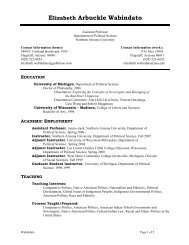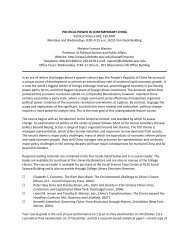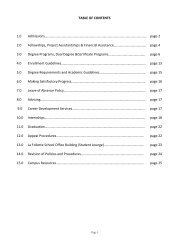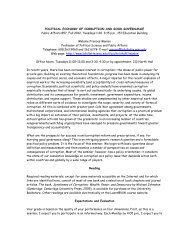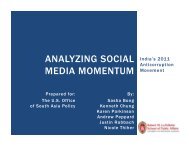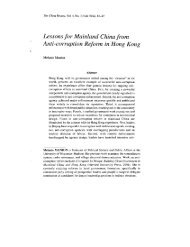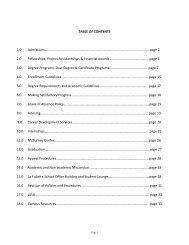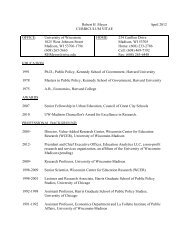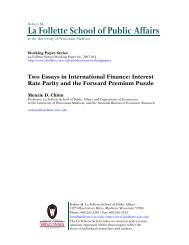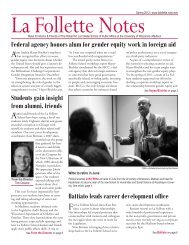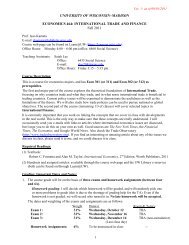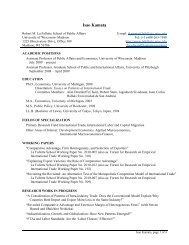SAVE Commission's findings - La Follette School of Public Affairs ...
SAVE Commission's findings - La Follette School of Public Affairs ...
SAVE Commission's findings - La Follette School of Public Affairs ...
You also want an ePaper? Increase the reach of your titles
YUMPU automatically turns print PDFs into web optimized ePapers that Google loves.
are accrued throughout the year, even when<br />
bargaining is not underway, in DER’s Division<br />
<strong>of</strong> Collective Bargaining. This is one area where<br />
the private sector already supports many highly<br />
skilled practitioners who could operate under<br />
DOA oversight.<br />
GOAL #21: REGULATION FOR RESULTS<br />
21.1<br />
Reform lawmaking. To address the source <strong>of</strong><br />
rule inefficiency, the Legislature will be required<br />
to use the new legislative impact statement<br />
process to consider more fully the implications<br />
<strong>of</strong> their initiatives and the resulting rules and<br />
regulations. The statement will address duplication,<br />
truth in cost, cost-benefit, comparative<br />
risk and whether the law is drafted for the exception,<br />
instead <strong>of</strong> the norm.<br />
21.2<br />
Eliminate or revise irrelevant rules. To allow<br />
government to focus on results, not process,<br />
irrelevant rules and the paperwork they require<br />
must be discontinued or modified in a deliberate,<br />
ongoing process, with input. The private<br />
sector, local government and citizens<br />
should participate, under deadline pressure,<br />
in an honest assessment <strong>of</strong> all regulations, including<br />
licensed pr<strong>of</strong>essions.<br />
21.3<br />
Increase the use <strong>of</strong> education as a prevention<br />
tool. To effectively allow citizens to do the right<br />
thing, regulatory agencies should redirect resources<br />
from micro-scrutiny <strong>of</strong> process and<br />
paperwork to education that gives citizens,<br />
businesses, local governments and communities<br />
the information they need to do the right<br />
thing.<br />
21.4<br />
Agencies must develop missions with performance<br />
indicators. To be effective, agencies<br />
must have mission statements that result in<br />
mission-critical goals that drive actions and<br />
investments. Agencies have missions but they<br />
don’t always have appropriate impact on management<br />
systems.<br />
21.5<br />
Agencies should earmark funds for public liaison.<br />
To address a serious shortcoming in<br />
most regulatory agencies, strategy-driven liaison<br />
efforts should address serious misinformation<br />
about the goals, content and administration<br />
<strong>of</strong> administrative rules. Failure to do so<br />
will further undermine agency credibility.<br />
21.6<br />
21.7<br />
21.8<br />
21.9<br />
21.10<br />
21.11<br />
21.12<br />
Designate the Joint Committee for the Review<br />
<strong>of</strong> Administrative Rules as the state’s regulatory<br />
ombudsperson. To address serious complaints<br />
from businesses, local governments and<br />
the legal pr<strong>of</strong>ession about poor technical quality<br />
<strong>of</strong> rules and agency coordination in rule<br />
development, designate and equip the Joint<br />
Committee for the Review <strong>of</strong> Administrative<br />
Rules as the state’s regulatory ombudsperson<br />
and quality control entity.<br />
Use meaningful participative techniques. To<br />
open up the regulatory process to the people,<br />
regulatory bureaucracies should more aggressively<br />
use citizen participation techniques and<br />
advisory bodies (subject to Sunset).<br />
Create exchanges to enhance understanding.<br />
To achieve a greater appreciation for conditions<br />
“on each side <strong>of</strong> the fence”, regulatory<br />
agencies, local governments and businesses<br />
should exchange staff in work experiences.<br />
Leverage technology to enhance participation<br />
and education. To enhance public input and<br />
education, agencies should use their own resources<br />
as well as the <strong>Public</strong> Information Utility<br />
in rule development, training, coaching and<br />
problem solving.<br />
Create a system <strong>of</strong> regulatory circuit riders.<br />
To provide more convenient services and address<br />
uneven application <strong>of</strong> rules across the<br />
state, create a circuit rider function that can<br />
result in on-site, consolidated permits based<br />
on the needs <strong>of</strong> the site, not the state agency.<br />
Use performance, not process, for regulatory<br />
systems. To move toward results-driven regulations,<br />
agencies and the Legislature should<br />
adopt cost effectiveness, comparative risk and<br />
a total regulatory impact analyses system and<br />
tools before setting priorities or making decisions.<br />
This will require major changes in budgeting,<br />
culture, skills and process in the Legislature<br />
and agencies and result in significant<br />
allocations <strong>of</strong> positions.<br />
Set enforcement priorities. To make best use<br />
<strong>of</strong> enforcement resources, set priorities and a<br />
means to address complaints and infractions<br />
<strong>of</strong> varying severity. Little is being done in this<br />
area now.<br />
CITIZEN • COMMUNITY • GOVERNMENT — WISCONSIN: THE 21 ST CENTURY 71



